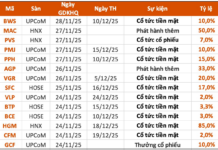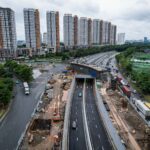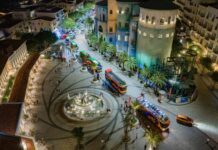Editor’s Note: Resolution 98/2023, issued by the National Assembly on June 24, 2023, aimed at piloting special mechanisms and policies for Ho Chi Minh City’s development, has yielded significant momentum over two years, as evidenced by positive socio-economic indicators. However, progress in attracting strategic investors—the coveted “eagles”—remains below expectations.
With Ho Chi Minh City’s recent territorial expansion and renewed aspirations, revising Resolution 98 is imperative. The series titled “Ho Chi Minh City Upgrades Resolution 98 to Welcome ‘Eagles'” by Phap Luat Ho Chi Minh City newspaper aims to provide a multifaceted analysis, identifying barriers and proposing actionable solutions to unlock strategic capital inflows the city seeks.
 Workers at Ho Chi Minh City’s High-Tech Park. Photo: QH |
Undeniably, with 36 out of 44 mechanisms implemented, Resolution 98 has injected new vitality into Ho Chi Minh City. Key metrics underscore this: average GRDP growth of 6.2% in 2023-2024, surging to 7.82% in the first half of 2025. Stable budget revenue growth of 8.5% annually, coupled with a 15% increase in new business registrations compared to pre-resolution periods.
Notably, residents’ living standards have markedly improved, with per capita GDP rising from VND 159.5 million (2022) to over VND 186 million (2024).
These macro figures are exemplified by tangible projects. The VietStar Integrated Solid Waste Treatment Plant in Cu Chi District, launched in March 2025, is a prime example. With an investment of VND 3.5 trillion and a capacity of 2,000 tons/day, it is the city’s second waste-to-energy plant enabled by Resolution 98. This project not only addresses the city’s urgent environmental challenge of 10,000 tons of daily waste but also advances a circular economy by converting waste into resources. Such initiatives highlight the resolution’s practical impact.
Lingering Challenges
Despite these achievements, significant challenges persist, particularly in technology-driven sectors.
At the Ho Chi Minh City High-Tech Park (SHTP), a hub of innovation, the landscape is mixed. As of October 2025, SHTP remains a magnet for investment, hosting 163 active projects totaling over USD 12.5 billion, with global leaders like Intel, Samsung, and Sanofi. Mr. Le Thanh Nhan, Head of Investment Promotion at SHTP Management Board, affirms Resolution 98 has charted the right course.
|
Expanding Horizons, Crafting New Institutions A new era has dawned, necessitating a commensurate institutional framework. The administrative merger of Ho Chi Minh City with Binh Duong and Ba Ria-Vung Tau (former) under Resolution 202/2025/QH15 has birthed a megacity with regional ambitions. Development now extends to coastal areas, economic corridors are reshaped, and new growth drivers emerge. SHTP leadership is optimistic about this potential. The merger synergizes regional infrastructure (Ring Road 3, Bien Hoa-Vung Tau Expressway, Long Thanh Airport), positioning SHTP to lead in semiconductor and AI value chains. This expanded scope demands an upgraded Resolution 98. |
Yet, paradoxically, attracting strategic investors as envisioned by Resolution 98 remains elusive. Mr. Nhan and colleagues cite persistent hurdles: stringent criteria for capital scale, disbursement timelines, and international experience; administrative procedures remain cumbersome.
Notably, in a submission to the Ho Chi Minh City Department of Finance regarding the draft amended Resolution 98, signed by Mr. Le Quoc Cuong, Deputy Head of SHTP Management Board, concerns were raised. Under the 2024 Land Law, state land management in SHTP (land allocation, leasing) falls under the city’s authority, no longer the management board’s. This erodes the “one-stop-shop” advantage, potentially prolonging investor procedures. Despite the “red carpet,” obstacles persist.
Identifying Systemic Barriers
While SHTP’s challenges are micro-level, a macro-level legal barrier has emerged over two years: investor selection processes.
Dr. Tran Quy, Director of Vietnam Digital Economy Institute, highlights the core conflict: inviting global conglomerates with advanced technology and capital, yet requiring them to compete in tenders. Clause 7, Article 7 of Resolution 98 mandates competitive bidding, an inflexible process mismatched with mega-projects where only a few global entities qualify.

Dr. Tran Du Lich, Chairman of the Resolution 98 Implementation Advisory Council, repeatedly stresses that this tender mechanism is the primary obstacle, complicating century-scale projects like the Can Gio International Transshipment Port. “The issue lies not in criteria but in the tender mechanism,” he asserts.
Beyond procedural barriers, impractical capital disbursement requirements pose another challenge. Resolution 98 mandates full investment disbursement within five years of licensing.
For billion-dollar infrastructure projects like the Can Gio Port (VND 113 trillion, 22-year lifespan, seven phases), this is unfeasible. This mismatch between policy design and global investment flows inadvertently deters long-term projects. These barriers render Resolution 98’s incentives inaccessible, diminishing interest from top-tier investors. Urgent removal of these bottlenecks is essential.•
|
Tailored Special Mechanisms Needed Clearly, the 2023 Resolution 98 framework no longer fits the megacity’s scale. Assoc. Prof. Dr. Tran Hoang Ngan, National Assembly Deputy, emphasizes that a city contributing 1/4 of national GDP and housing over 14 million requires tailored mechanisms for infrastructure and governance. Current conditions demand a new vision and development space. Revising Resolution 98 transcends technical adjustments; it necessitates institutional innovation, granting Ho Chi Minh City autonomy and flexibility. Proposals include direct investor designation, extending disbursement to 10 years, and decentralized planning—bold solutions. “This is the moment to transform Resolution 98 from a policy framework with hurdles into a robust legal ‘runway’ for global economic ‘eagles’ to land and take off, propelling Ho Chi Minh City onto the regional and global economic map,” observes Assoc. Prof. Dr. Tran Hoang Ngan. |
QUANG HUY – THU HÀ
– 07:18 24/11/2025
Riverside Living – Gaze Upon Phu My Hung: Experience the Expansive Views from Sunshine Sky City
Nestled in the vibrant heart of South Saigon, Sunshine Sky City stands as a rare gem, offering a true sense of openness. Here, every day is bathed in natural light, cooled by the gentle river breeze, and framed by endless vistas stretching toward the iconic Phu My Hung center.
Four New Residential Projects in Ho Chi Minh City Receive Land Ownership Certificates
Discover the epitome of luxury living in the garden villa area of Hiệp Bình Ward, the Cluster B apartments at Saigon Intela, and the 12-story residential building within the 10-hectare resettlement area of Đông Hưng Thuận Ward. Explore the elegance of Opal Riverside apartments and the Bến Lức Residential Area project, now under review to provide land ownership certificates for homeowners.













































